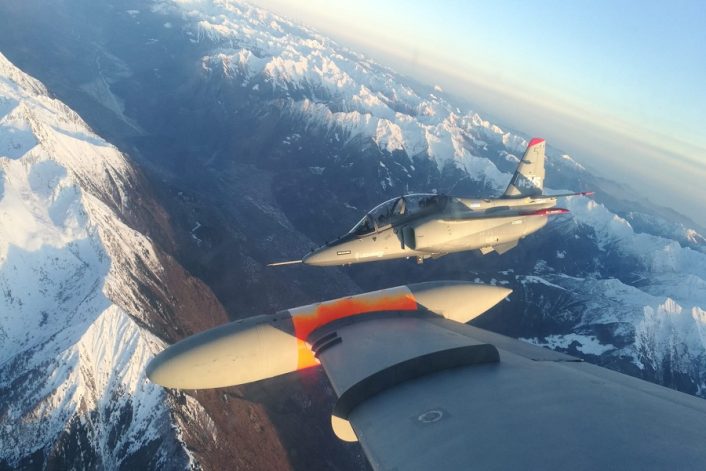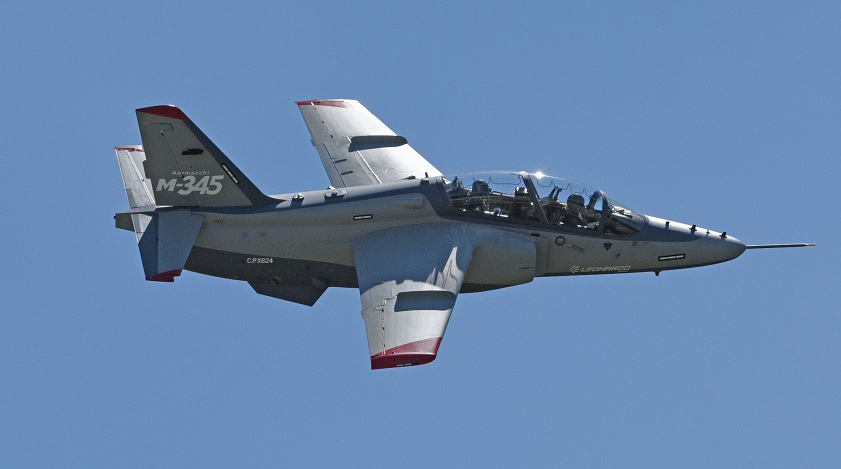The Italian Air Force ordered 18 aircraft to begin replacing the aging MB-339.
The Directorate for Air Armaments and Airworthiness (DAAA), the Italian Ministry of Defense’s Certification Authority, issued the “Initial Certification” for the new M-345 training aircraft produced by Leonardo and ordered by the Italian Air Force. The important milestone was reached after 200 test flights performed by the company initially and later also by the Italian Air Force’s Flight Test Centre (Reparto Sperimentale Volo) supported by the 61st Wing (61° Stormo) and 10th Aircraft Maintenance Unit (10° Reparto Manutenzione Velivoli). The latter two units will fly and maintain respectively the T-345A (military designation of the aircraft) when it will be deployed in service.
#Leonardo‘s new #M345, close to entering into service with the @ItalianAirForce, and future aircraft of the Italian Airforce acrobatic team @FrecceTricolori, is an aircraft capable of providing jet trainer aircraft-like performance and efficiency at the cost of a turboprop. pic.twitter.com/oCNPPbYwKi
— Leonardo Aircraft (@LDO_Aircraft) May 8, 2020
“The achievement of the Initial Certification for the M-345 – unique in its segment for acquisition and operational costs – confirms the aircraft features excellent characteristics and capabilities and makes it available for the international market. This result stems from a consolidated collaboration between the industry, the Certification Authority and the Italian Air Force under a full national effort and embodies the heritage in training excellence which is widely acknowledged to the Italian Armed Forces”, said Lucio Valerio Cioffi, Managing Director of Leonardo Aircraft Division.
In the official press release, the company noted that the M-345 is also the first aircraft to be certified in accordance with the new European EMAR-21 – (European Military Airworthiness Requirements) and its national implementation AER (EP) P-21. The new certification requirements are derived from EASA (European Aviation Safety Agency), which is in turn based on ICAO (International Civil Aviation Organization) regulations, and are based on the aircraft safety hazards and their possible outcomes in an effort to reduce them as much as possible. The safety requirements are also designed to be mutually recognized by different nations.
The M-345 development benefited from the lessons learned with the M-346 “Master” to provide an improvement in training effectiveness, increased efficiency and a reduction of operating cost (Leonardo noted that operating costs will be comparable to a turboprop aircraft), thanks also to the Integrated Training System and “Live Virtual Constructive” capability developed for the M-346 and now adapted for the M-345.

The Italian Air Force has ordered 18 M-345 aircraft, with plans to field up to 45 new aircraft, to replace the ageing MB-339 used for training and for the Frecce Tricolori display team. Deliveries of the T-345A will start later this year to its new base at Lecce-Galatina Air Base, home of the 61st Air Wing.
Here’s what our Editor David Cenciotti wrote in a previous article about how the T-345 will change the training of the new pilots:
With the IPTS-2020, the training paradigm has turned from Generalized to Specialized: unlike what happened in the past, when all the student pilots (SPs) who had passed the initial flight screening (Phase 1) received the same instruction until graduation (end of Phase 3), with the SUPT (Specialized Undergraduate Pilot Training) all the SPs get the same education only during the initial and basic jet training (Phase 2), currently carried out by 213° Gruppo on the T-339A, then they are assigned to one of four different tracks based on skills: Fighter, Multi-engine, Helicopter or RPA (Remotely Piloted Aircraft). Those who are selected to continue with a Fighter track assignment remain at Lecce with the 213° to undertake the Advanced and Tactical jet training (Phase 3). Upon finishing Phase 3, SPs are awarded the “Military Pilot” license, earn the pilot wings and then move on to LIFT (Lead-In to Fighter Training) course (Phase 4) carried out by 212° Gruppo on the T-339C and the T-346A.
The plan is to field around 45 M-345 (to be designated T-345) to replace a fleet of 137 MB-339A and CD delivered since the early 80s. The new aircraft will also become the new platform of the Italian Air Force’s Frecce Tricolori display team.
Therefore, in the future, Phase 2 and 3 should be carried out with the M-345 and Phase 4 will be carried out by M-346 “Master” Advanced Jet Trainers (18 of those are already in service with the Italian Air Force). Dealing with the latter ones, during Farnborough Air Show 2018, Leonardo’s CEO, Alessandro Profumo, and the Italian Air Force Chief of Staff, Lt. Gen. Enzo Vecciarelli, signed a collaboration agreement to strengthen the training services already offered by the 61° Stormo and to establish an all new “International Flight Training School” (IFTS) to support military pilot training.













